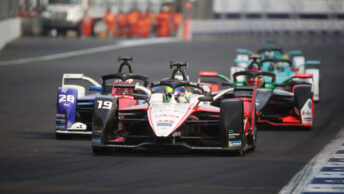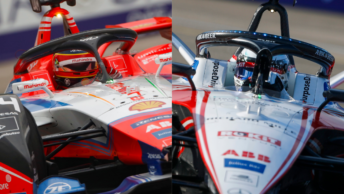What a year it’s been! Formula E Season 6 delivered some truly spectacular moments and featured one of most competitive grids seen in top-level motorsport.
Some of the 28 drivers to have raced this season achieved unimaginable career highs, while one or two others will want to quickly forget these past 10 months ever happened.
With no racing now until January, we though it was a good time to hand out our end of term grades, and we’re kicking things off with champions DS TECHEETAH and runners-up NISSAN E.DAMS…
- DS TECHEETAH
António Félix da Costa 🇵🇹
1st in the championship with 158 points
Grade: A
Considering this was Antonio Felix da Costa’s first season with the team, and with a two-time champion team-mate alongside him to boot, his performances overall have been nothing short of extraordinary. By all accounts, the man he replaced – André Lotterer – was no slouch, but in two years with DS Techeetah, the German never came close to rattling Jean-Éric Vergne in the way that the likeable Portuguese has managed this season.
His final tally of 158 points from 11 races placed him 71 points clear of second place driver Stoffel Vandoorne; by a country mile the largest margin of victory for any Formula E champion so far – and he set a new record by winning the title with two races to spare; the earliest anyone’s done that.
In comparison to Vergne, da Costa held the edge in almost every area statistically. He outscored Vergne 3-1 on race wins (Marrakesh and the opening two Berlin races – all three were from pole), finished in the points more often (9-7), and was 6-3 ahead in podium finishes.
During the second of his three wins, da Costa set a new Formula E record becoming the first driver in the series’ history to take a maximum 30 point score from one event – a feat achieved by topping group stage qualifying, converting that to pole, and then taking the combo of race win and fastest lap to round things off.
Aside from the obvious highlights (his three wins), he was equally as impressive during recovery drives to take second place in Santiago and in Mexico City after starting those races from 10th and 9th place respectively, and has shown a combative street fighting style when forced to manoeuvre his way through the field.
In qualifying, da Costa was quick, and sometimes really bloody quick! He had a remarkable run of three consecutive pole positions between Marrakesh and the second Berlin race (a record he shares with Alexander Sims) and made it to superpole five times overall from 11 races – a highly respectable record considering he qualified from Group 1 in eight of those.
Da Costa has a huge challenge ahead to retain his crown next season as Vergne has vowed to come back fighting, not to mention there’ll be other drivers who’ll feel capable of mounting a more serious challenge providing we (hopefully) have a more consistent calendar of races.
Nevertheless, da Costa has more than proven this season that he’s neither fazed by the prospect of challenging Vergne in his own backyard, nor has any of his speed or sharpness been blunted by five previous seasons fighting for minor points more often than podiums.
His was a seriously impressive season by anyone’s standards, and one which might yet prove to be the making of him.
Jean-Éric Vergne 🇫🇷
3rd in the championship with 86 points
Grade: B+
Jean-Eric Vergne described his season as “horrible” and bemoaned the spate of technical difficulties and bad luck he faced that blunted his challenge for a third-consecutive title. In reality, while he did experience more bad luck than his team-mate, Vergne was a little off his usual extremely high standards for much of this season, and it showed in his final points tally of 86 – his lowest since his rollercoaster campaign with DS Virgin.
While Vergne experienced more mechanical issues than da Costa (3-1 on DNFs), the Portuguese tended to be the slightly quicker of the two when it really mattered and that’s why he bagged more points than Vergne during those races when a win or podium finish looked on for them.
Vergne’s average starting position for the season was an underwhelming 11.1, although this was skewed slightly by him being forced to start 24th in Diriyah (battery change) and in Berlin Race 5 (failed to set a time), and then 21st in Berlin Race 6 (Group 1 track evolution). His qualifying woes aside, he did bag two pole positions and the first of those was absolute fire – a 0.495s gap to Max Günther in Berlin Race 3 was the largest margin anyone achieved all season.
Notwithstanding his brace of race wins (he’s up to joint-third now on the all-time list), two of his best drives this season were ones that flew under the radar somewhat. His storming recovery drive from 21st to 7th in Berlin Race 6 was a masterclass in controlled overtaking (easier said than done when you’re feeling pissed off), but perhaps the standout moment of Vergne’s season was his drive from 11th to take the final podium spot in Marrakesh. On paper it wasn’t a spectacular result, but Vergne was dog rough that weekend with a 40° fever (not COVID) and had been forced to miss shakedown after being hospitalised the day before.
So what next for Vergne after what can only be described as a disappointing season? Well, he’s already conceded that he needs to become “better at losing” as he believes it would help him to bounce back quicker – something you can be sure he’ll do next season. Secondly, as he noted in himself on social media, if you can have a season like he’s had and still finish third and add to your win tally, it can’t all be doom and gloom!
- NISSAN E.DAMS
Sébastien Buemi🇨🇭
4th in the championship with 84 points
Grade: A-
It wouldn’t be a Formula E season without Sebastien Buemi being somewhere in the mix at the front, but for only the second time in six seasons, it proved to be a winless campaign for the Swiss former champion. That’s not to say, however, that it’s been an altogether unfruitful one.
Dropping from second in the drivers’ standings last season to fourth this time around might appear from the outside to be a major disappointment for Buemi, but given the context of the challenging season he and the Nissan e.dams have faced, there’s very good reason to see his result as a success.
Buemi explained in Berlin that the FIA’s decision to ban Nissan’s innovative twin-motor powertrain at the end of last season “massively” affected their preparation for this one. He claims the team had to refocus their efforts on playing catchup to the other teams, and therefore, spent little time focusing on improving energy management as might otherwise have been the case during the off-season.
Perhaps the most remarkable point to note in Buemi’s late surge to fourth in the final standings is that he did so having failed to score a single point in the opening three races. A battery issue and contact while running second left him point-less from the opening event in Diriyah, while a broken regen paddle caused the power spike that earned him a 30-second time penalty in Santiago.
Aside from a few frustrating early-season lows, Buemi recovered well to score podiums in Mexico City and in three of the six Berlin races to finish the season strongly. His highlights though often came in qualifying, and the the 14-time polesitter showed he’s lost none of his pace; averaging the best average starting position (7.4) of any driver to have raced the whole the season and was also the most frequent visitor (eight times from 11 races) to superpole.
If Nissan e.dams can find some small gains on race pace, Buemi could once again be a title contender next season.
Oliver Rowland 🇬🇧
5th in the championship with 83 points
Grade: B+
Little was expected of Oliver Rowland last season given the last minute nature of his call to replace the F1-bound Alex Albon, but now, 20 months on, what an incredible turn of events that’s proven to be in the Yorkshireman’s career. This season he’s matured into a seriously impressive top level racing driver and the future’s looking very bright for him in Formula E.
Rowland ran Buemi close at times during his rookie campaign, but this year he’s added a wileyness to his racecraft to compliment the raw speed we all know he has. The end result? He was Nissan e.dams sole race winner this year, and trailed the much more experienced Buemi by just a single point in the final standings – the gap was 48 last season.
Part of the key to Rowland’s upturn in results this season has been in his consistency. With eight points finishes from 11 races, only Lucas di Grassi (Mr. Consistency himself) and da Costa, the man who dominated the championship, boast better records.
The stats also reflect how strong Rowland was at moving forwards from wherever he qualified, perhaps a necessity given that he lacked a little of Buemi’s raw one lap speed this season. At an average of 4.7 positions gained per race, Rowland’s figure is the second best on the grid.
The one minor negative to Rowland’s otherwise extremely successful campaign was his huge practice crash in Santiago, which the Brit admits dented his confidence and potentially slowed him a little for a few races afterwards.
Providing there are no repeats of that, Rowland can regularly expect to be in the conversation for big results next season with Nissan e.dams looking well placed to be title challengers.
Coming up: Part 2 featuring Mercedes EQ and Envision Virgin





